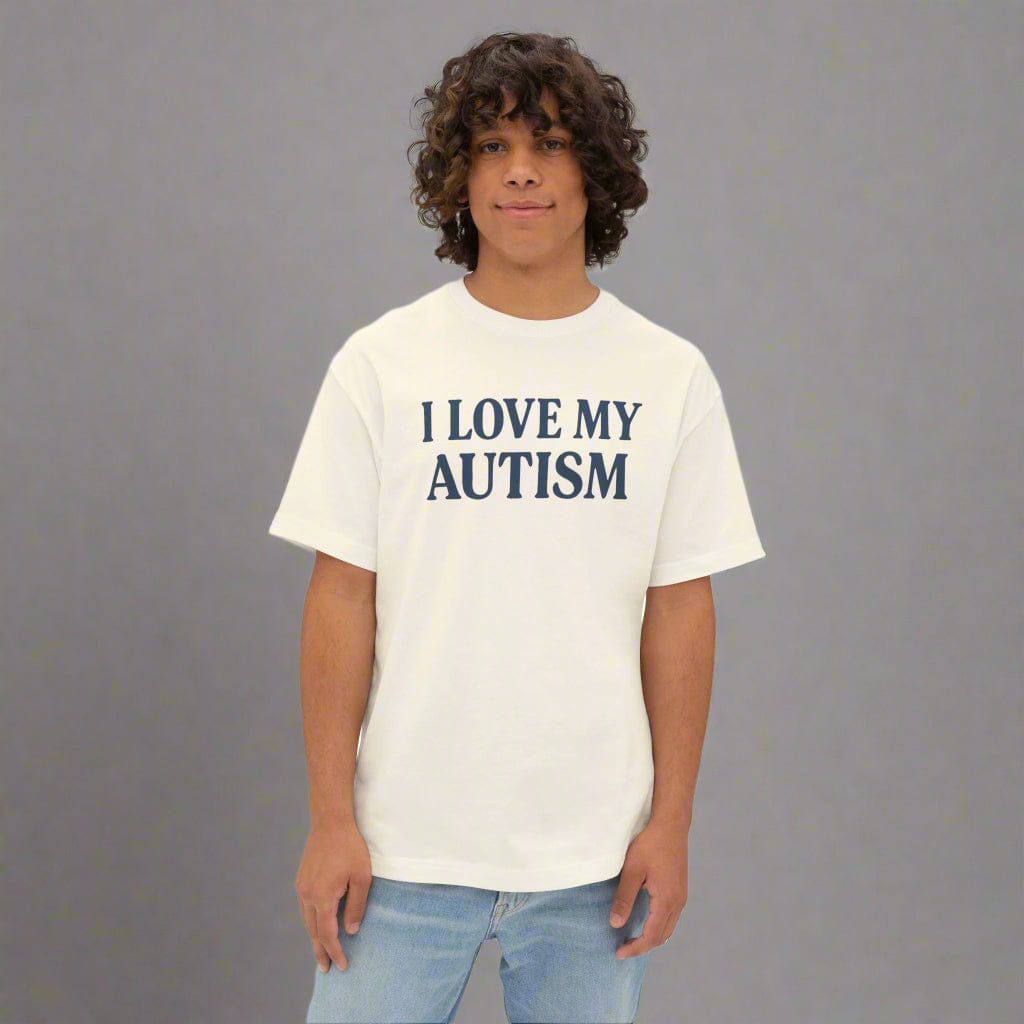Autism and Stress: Understanding, Managing, and Finding Calm
Stress isn’t a personal failure, it’s a signal. This guide explains why stress for autistic adults feels different, common triggers like masking and sensory overload, and practical ways to find calm through routines, boundaries, and sensory-safe supports that actually help.

Written by the HeyASD Editorial Team
Autistic stress often comes from a world that expects constant adaptation. This article reframes stress as a signal, not a flaw, and offers calm, practical strategies—rooted in autistic lived experience—to help you reduce overwhelm and recover your energy.
“On ‘good’ days I can hold it together. On ‘normal’ days, the lights buzz, the tags itch, the small talk stacks up, and my body quietly hits its limit. I’m not broken. I’m overstimulated.”
— Autistic adult, lived experience
Below, you’ll find the most common triggers of autistic stress (sensory, social, and internal), how to recognise early signs, and gentle practices that make daily life feel safer and more manageable.
Why Stress Feels Different for Autistic People
The stress response for autistic people is not just more frequent; it is fundamentally different. It's often rooted in a constant state of high alert caused by sensory sensitivities and the immense energy required to navigate social situations. This experience is shaped by a nervous system that processes the world with incredible detail and intensity.
This unique wiring means that the autistic brain reacts to stimuli that neurotypical brains might filter out, leading to a much lower threshold for overwhelm. The following sections will explore the specific reasons why stress manifests so differently, from sensory overload to the distinct experience of autistic burnout.
The Foundation: Autism and Stress in Daily Life
For many autistic people, chronic stress is woven into the fabric of daily life. Simply moving through a culture and environment that don't match your needs can be a source of constant strain on your nervous system. This isn't about a single stressful event but the cumulative effect of small, daily mismatches.
Living in a world that isn’t built for your autistic traits means you're constantly adapting, translating, and processing. This can come from anxiety-inducing social scenarios, unwelcoming work environments, or overly stimulating public spaces. The autistic brain is often working overtime just to exist in these settings.
This continuous effort is what lays the foundation for chronic stress. It’s not that you are less resilient; it's that your daily life demands a level of navigation and adaptation that can be incredibly draining, making your experience of stress a constant presence rather than a temporary state.
Sensory Overload and Its Unique Challenges
One of the deepest connections between autism and chronic stress is sensory overload. Autistic people often perceive sensory input with a higher intensity, and their brains may not get used to or "acclimatize" to stimuli. What might be background noise to a neurotypical person can feel like a direct threat to an autistic nervous system.
This heightened sensitivity means that everyday environments can quickly become overwhelming. The constant barrage of sensory information contributes directly to a state of chronic stress, as your system is always on high alert. This isn't a preference; it's a neurological reality.
Common triggers for sensory overload include:
-
Auditory input: Loud machines, multiple conversations, or specific music frequencies.
-
Visual input: Bright, flickering lights, busy patterns, or crowded places.
-
Tactile input: The texture of certain clothing, an unexpected touch, or stepping on an unwanted surface.
Social Exhaustion and Navigating Social Spaces
Social engagement can be a significant source of stress and exhaustion for autistic individuals. Navigating social situations often requires immense cognitive effort, from interpreting nonverbal cues to monitoring your own responses to fit in. This constant mental work is incredibly draining.
Unlike neurotypical social interaction, which can be energizing, social situations for an autistic person can feel like a performance. You might be constantly practicing conversations in your head or trying to follow unwritten social rules. This isn't about a lack of social skills, but rather about the energy it takes to participate in a world with different communication norms.
This sustained effort leads to social exhaustion, a profound fatigue that comes from social engagement. When you're already managing sensory input and internal stress, the added layer of social processing can quickly deplete your energy reserves, making even enjoyable gatherings a source of stress.
The Double Empathy Problem and Miscommunication Stress
A lot of social stress for autistic people comes from what is known as the "double empathy problem." This idea suggests that communication breakdowns between autistic and neurotypical people are a two-way street, caused by a mismatch in communication styles, not a deficit in the autistic person.
When you communicate in a way that is natural for you, it may be misinterpreted by neurotypical people. Likewise, their reliance on subtle social cues can be confusing for you. This gap in understanding leads to frequent miscommunication, which is a powerful and persistent stressor.
Feeling constantly misunderstood can increase social anxiety and make you hesitant to engage. The stress doesn't come from an inability to connect, but from the exhausting effort of trying to bridge a communication gap that others may not even see. It reinforces a feeling of being out of sync with the world around you.
Emotional Vulnerability — Stress as a Response to Mismatch
Your stress response is not a sign of weakness; it is a signal of a mismatch. When an autistic individual experiences intense stress, it is often the nervous system's way of saying that the demands of the environment are exceeding their capacity to cope. This is a state of emotional vulnerability, not a failure of emotional regulation.
This mismatch can happen anywhere—at work, in social gatherings, or even at home. The autistic brain, processing the world with such depth, is simply trying to protect itself from stimuli that have become too intense or overpowering. Your stress is a logical reaction to an illogical set of expectations.
Understanding this changes everything. Instead of trying to "fix" your response, you can start to see it as valuable information. Your stress is pointing you toward what needs to change in your environment, not what is wrong with you. This shift in perspective is a crucial step toward self-acceptance and better mental health.
Autistic Burnout vs. General Stress — What’s Distinct
It is vital to understand that autistic burnout is not the same as general stress or even neurotypical burnout. While stress can be a temporary state, autistic burnout is a result of prolonged, chronic stress that completely depletes an autistic person's physical, emotional, and cognitive resources. This is especially common in late-diagnosed autism, after years of unconscious masking.
Unlike general burnout, which is often tied to a specific job, autistic burnout stems from the cumulative effort of simply existing in a neurotypical world. It's a state of profound exhaustion that goes much deeper, often impacting core abilities.
The key features that distinguish autistic burnout are:
-
Chronic exhaustion: A deep, pervasive fatigue that isn't relieved by rest.
-
Loss of skills: Suddenly struggling with abilities you once had, such as socializing, executive functioning, or even verbal communication.
-
Reduced tolerance to stimulus: An increased sensitivity to sensory input and social demands, making things you could previously handle now feel impossible.
Neurobiology of Stress and Autism Compared to Neurotypicals
The stress response in autistic people has distinct neurobiological roots. The autistic nervous system is wired differently, impacting everything from brain structure to the chemical messengers that regulate stress. For example, research suggests autistic brains may not habituate to certain stimuli, meaning the stress response remains high instead of decreasing with exposure.
This sustained activation can affect the HPA axis, the body's central stress response system, leading to different patterns in cortisol response compared to neurotypical brains. Brain regions like the amygdala, responsible for processing emotions, may be larger or more active, contributing to heightened emotional sensitivity and anxiety.
These differences mean that the experience of stress is not just a matter of perception but is physically and neurologically distinct.
|
Feature |
Autistic Brain |
Neurotypical Brain |
|---|---|---|
|
Brain Connectivity |
Often shows short-range over-connectivity and long-range under-connectivity. |
More balanced connectivity between regions. |
|
Stimulus Habituation |
May not "get used to" repeated sensory or social stimuli. |
Tends to habituate, reducing the stress response over time. |
|
Amygdala Activity |
Can show heightened or atypical activity, linked to intense emotional responses. |
Typically shows a more regulated response to emotional triggers. |
|
Sensory Processing |
Processes a higher volume of sensory data, leading to easier overload. |
Filters out more sensory information, preventing overload. |
Common Triggers for Stress in Autism
For autistic people, stress triggers can be everywhere. They are not always large, dramatic events but are often woven into the small details of daily life. These triggers can be external, coming from environmental factors, or internal, stemming from your own thought processes and bodily sensations.
Understanding your specific triggers is a key part of managing stress. By identifying what causes your nervous system to feel overwhelmed, you can begin to create strategies to either avoid, prepare for, or mitigate their impact. The following sections will explore some of the most common stressors faced by autistic adults.
Sudden Change and Unpredictable Environments
For many autistic people, predictability is a lifeline. Daily routines and consistent environments provide a sense of safety and control in a world that can often feel chaotic. When that predictability is broken by a sudden change, it can be extremely distressing.
This isn't about being inflexible. It's about the cognitive and emotional energy required to re-orient yourself when your mental map of the day is disrupted. A sudden change forces your brain to process new information and adjust expectations, all of which drains your limited energy reserves and elevates your stress response.
Common examples of this trigger include:
-
An unexpected detour on your usual route.
-
Last-minute changes to plans with friends or family.
-
A familiar store rearranging its layout.
Masking, Camouflaging, and Emotional Suppression
Masking, or camouflaging, is the act of consciously or unconsciously hiding your autistic traits to fit in with neurotypical expectations. This can involve forcing eye contact, suppressing stimming, or scripting conversations. While it can feel like a necessary survival tool, it is a significant and exhausting source of stress.
The constant effort of monitoring your natural social behavior and performing a "neurotypical" version of yourself is incredibly draining. This emotional suppression is like holding a beach ball underwater; it takes immense energy, and eventually, it will spring to the surface, often in the form of a meltdown, shutdown, or burnout.
One of the most powerful strategies to manage daily stress is to find safe spaces and relationships where you can unmask. Allowing yourself to be authentically autistic, even for short periods, can dramatically reduce the chronic stress that comes from a lifetime of camouflaging.
Environmental Factors: Light, Sound, and Texture
The physical environment is a major source of stress for many autistic people due to heightened sensory sensitivities. Your nervous system may process sensory input like light, sound, and texture with an intensity that can quickly become painful and overwhelming.
Things that are barely noticeable to others can be significant environmental factors for you. A fluorescent light's hum, the scratchy tag on non-autistic-designed clothing, or the overlapping sounds in a café can all contribute to sensory overload and a state of high alert.
Here are some specific examples of environmental triggers:
-
Light: Bright overhead lighting, flashing advertisements, or the glare of the sun. An autism hat can help manage this.
-
Sound: Unexpected loud noises, high-pitched frequencies, or the constant din of a crowd.
-
Texture: The feel of certain fabrics, the texture of some foods, or being touched unexpectedly.
Disruption of Routines: Predictability and Comfort
Daily routines are far more than just habits for autistic people; they are a fundamental tool for comfort and self-regulation. Routines create a predictable structure for the day, which frees up mental energy that would otherwise be spent navigating uncertainty. This predictability is calming to the nervous system.
When a routine is disrupted, it can feel like the ground is shifting beneath your feet. It’s not just an inconvenience—it’s the removal of a crucial support structure. The stress response that follows is a reaction to the sudden loss of safety and control.
This is why protecting your routines is a valid and important form of self-care. Honoring your need for predictability is not about being rigid; it's about giving your brain the consistency it needs to function well in a world that is often unpredictable and demanding.
Internal Triggers: Interoception, Self-Doubt, and Overwhelm
Not all stress triggers are external. Many come from within, originating from your internal experiences and thought patterns. Difficulties with interoception—the sense of your body's internal state—can be a major trigger. If you struggle to identify signals like hunger, thirst, or fatigue, you may not realize you're approaching your limit until you're already overwhelmed.
Co-occurring anxiety disorders are also common, and the cycle of anxious thoughts can be a powerful internal stressor. This can be compounded by self-doubt, especially if you've spent your life feeling misunderstood or "different." The internal narrative of not being good enough is profoundly stressful.
This sense of internal chaos contributes to a feeling of overwhelm, where your mind feels too full to process anything else. Learning to recognize these internal triggers is a key part of emotional regulation, allowing you to respond to your needs before you reach a crisis point.
How Social Context and Expectations Intensify Stress
Social stress for autistic individuals is not just about being around people; it's about the context and the unspoken expectations that come with it. Different social contexts, like a work meeting versus a casual hangout, come with entirely different sets of unwritten rules that you are expected to understand and follow.
The pressure to "get it right" in these situations is immense. You may be constantly analyzing the situation, trying to decipher the correct social behavior, and worrying about being misunderstood. This hypervigilance is a major source of social stress and mental exhaustion.
This is why some social situations are more stressful than others. A structured activity with clear rules may be enjoyable, while an unstructured party with ambiguous expectations can be terrifying. The stress comes from the unpredictability and the high stakes of potentially violating social norms you were never taught.
The Impact of Gender and Intersectionality on Stress Experiences
The experience of stress for autistic adults is not universal; it is shaped by factors like gender and other intersecting identities. Autistic women, for example, are often socialized differently and may face unique pressures to be socially adept and emotionally available, leading to more intense and sophisticated masking.
This high level of masking can make their stress less visible to others, but it creates profound internal, chronic stressors. The constant performance can lead to a disconnect from their own needs and a higher risk of autistic burnout. Under-diagnosis in women also means they often navigate these challenges without understanding or support.
Stress experiences are impacted by:
-
Masking: Autistic women may mask more heavily, leading to internalized stress and delayed diagnosis.
-
Intersectionality: Being autistic and also a person of color, LGBTQ+, or disabled in other ways adds layers of societal pressure and unique stressors.
-
Social Expectations: Gendered expectations around communication and emotional expression create different social hurdles and sources of stress.
Signs and Symptoms of Stress in Autism
When autistic people experience stress, the signs can look very different from neurotypical stress responses. These signals are your nervous system's way of communicating that it is overwhelmed. Learning to recognize these signs in yourself is a powerful act of self-advocacy and self-care.
The symptoms of stress can manifest emotionally, physically, and behaviorally. They might be explosive and external, like a meltdown, or quiet and internal, like a shutdown. The following sections will detail these specific signs, helping you better understand what your body and mind are telling you.
Emotional Signs: Shutdowns, Anxiety, Irritability
An autistic shutdown is a common emotional and neurological response to extreme stress or overload. It is an involuntary self-protective mechanism where an autistic person inwardly retreats from their surroundings. During a shutdown, your brain is trying to shield your nervous system from stimuli that have become too intense.
This state can be misinterpreted as apathy or rudeness, but it is a sign of profound distress. You might find yourself unable to speak, respond, or process information. It's a temporary loss of skills caused by an overloaded system.
Key emotional signs of stress and impending shutdown include:
-
Withdrawal: Becoming unresponsive, distant, or appearing emotionally detached.
-
Increased anxiety: A sharp spike in feelings of panic or dread.
-
Irritability: Feeling easily angered or frustrated by small things.
Physical Manifestations: Fatigue, Tension, Stimming Changes
Stress in autistic people doesn't just live in the mind; it manifests physically in the body. One of the most common signs is a deep, pervasive fatigue. This isn't just regular tiredness; it's a bone-deep exhaustion that comes from a constantly activated nervous system.
You might also notice increased muscle tension, particularly in your shoulders, neck, and jaw, or experience sudden tension headaches. Your motor coordination might feel off, and movements can become slower or less precise as your brain struggles to manage the overload.
Changes in stimming are another key physical sign. Your stims might become more frequent, more intense, or more forceful as your body tries to regulate the overwhelming stress. Alternatively, you might stop stimming altogether as you retreat inward. Paying attention to these physical signals can warn you that your stress levels are becoming unmanageable.
Behavioral Indicators: Meltdowns and Withdrawal
When stress becomes too much for an autistic person to contain, it can result in clear behavioral indicators. These responses are often polarized, appearing as either an external explosion (a meltdown) or an internal retreat (withdrawal or a shutdown).
An autistic meltdown is an intense, outward expression of distress. It is not a tantrum or a choice. It is an involuntary response to sensory or emotional overwhelm, where the person loses temporary control. On the other hand, withdrawal is a more muted reaction. This involves pulling away from social interaction and the environment to conserve energy and reduce stimulation.
Both of these behaviors are signs that an autistic person's capacity to cope has been exceeded. They are not bad behavior but desperate attempts by a dysregulated nervous system to find safety and regain equilibrium. Recognizing them as signs of distress is the first step to providing support.
Routine Rigidity as a Signal of Stress
While daily routines are a source of comfort, an increase in routine rigidity can be a clear signal of rising stress. When you feel overwhelmed or like the world is out of your control, you might find yourself clinging more tightly to the things you can control—your routines.
This isn't a desire to be difficult or inflexible. It's a coping mechanism. The predictability of a strict routine provides a sense of safety and reduces the cognitive load of making decisions or navigating uncertainty. When your stress response is high, your capacity to handle unpredictability is low.
If you notice yourself becoming more rigid about your daily routines, see it as a message from your nervous system. It's telling you that you're under too much strain and need to reduce demands or find other ways to feel safe and grounded.
Recognition of Stress Meltdowns in Autism
An autistic meltdown is one of the most misunderstood symptoms of autism and stress. It's a dramatic, external reaction to being completely overwhelmed. Unlike a shutdown, where the energy implodes inward, a meltdown is an explosion of distress that the person cannot control.
Meltdowns are often triggered by a culmination of stressors, such as sensory overload, emotional overwhelm, or a sudden change in a social situation. It's the final signal that an autistic person's nervous system has been pushed far past its limit. Recognizing a meltdown for what it is—a cry for help, not a behavioral issue—is crucial.
Signs that a meltdown is occurring or imminent can include:
-
Intense verbal expressions like shouting or crying.
-
Physical actions like kicking, hitting, or running away.
-
A temporary inability to communicate or respond logically.
Differentiating Stress in Autism from Typical Stress Responses
The stress response in autistic people is qualitatively different from that of neurotypical brains. While everyone experiences stress, the triggers, manifestations, and long-term consequences are unique for the autistic community, stemming from a nervous system that interacts with the world differently.
For neurotypicals, stress is often tied to specific, identifiable pressures like work deadlines or relationship conflicts. For autistic people, stress is frequently a baseline state caused by the constant effort of navigating a sensorily and socially overwhelming world. This leads to distinct outcomes that are not typically part of the neurotypical stress experience.
Key differences include:
-
Triggers: Autistic stress is often sensory- or routine-based, whereas neurotypical stress is more commonly situational.
-
Manifestations: Autistic stress can lead to meltdowns, shutdowns, and loss of skills, which are not typical stress responses.
-
Resolution: Autistic burnout requires radical rest and demand reduction, unlike general burnout, which may be resolved by changing jobs or taking a vacation.
Effects of Stress and Autism on Social Functioning
High levels of stress have a profound impact on social functioning for autistic people. The energy that stress consumes is the same energy needed for social processing, communication, and masking. When your system is already in a state of high alert, your capacity for social behavior is significantly reduced.
This can make social interactions feel even more difficult and draining than usual. Stress can impair your ability to process social cues, formulate responses, and manage the anxiety that often accompanies social situations. The following sections explore how this depletion of resources affects communication, relationships, and the ability to engage with others.
Navigating Social Interaction Under Stress
When you are under stress, navigating social interactions can feel like trying to run a marathon you haven't trained for. The cognitive resources required to analyze social cues, predict outcomes, and perform expected social behaviors are already depleted, leaving you with very little capacity for engagement.
Under stress, your ability to mask or camouflage your autistic traits diminishes. The "filter" that helps you navigate neurotypical social spaces may disappear, making you appear more blunt, quiet, or awkward. This isn't a failure of social skills; it's a sign that your brain is prioritizing survival over social niceties.
This can create a difficult cycle: stress makes social interaction harder, and the struggle of social interaction creates more stress. Recognizing this connection allows you to be kinder to yourself and give yourself permission to opt out of social situations when you don't have the energy for them.
Social Misunderstandings and Double Empathy
Stress significantly worsens the "double empathy problem," widening the communication gap between autistic people and their neurotypical peers. When you're stressed, you have less energy to "translate" your natural communication style into one that neurotypicals can easily understand.
At the same time, neurotypical people may misinterpret your stress signals. Your withdrawal might be seen as disinterest, or your directness might be perceived as rudeness. This lack of social understanding on their part can lead to negative feedback, which in turn increases your stress.
This can lead to a painful cycle of social misunderstandings:
-
Your stress causes you to communicate differently (e.g., becoming nonverbal or very direct).
-
A neurotypical person misinterprets this as a negative social signal.
-
Their reaction (e.g., confusion, hurt, or anger) adds to your existing stress.
Impacts of Stress on Communication
One of the most immediate impacts of high stress is on communication. For many autistic people, the ability to speak can be one of the first skills to diminish when overwhelmed. The part of the brain responsible for language can become temporarily inaccessible as your system redirects all its resources to managing the threat.
This can manifest as situational mutism, where you are completely unable to speak, even if you want to. In less extreme cases, your speech might become limited to short, one- or two-word responses. You might struggle to find words, form coherent sentences, or even process what others are saying to you.
This breakdown in communication is not a choice. It is a physiological response to an overloaded nervous system. Understanding this can help you and others respond with patience rather than pressure, which is crucial for reducing stress and allowing your communication skills to return.
Shutdowns and Social Withdrawal
Shutdowns are a direct consequence of stress, and they have a massive impact on social engagement. A shutdown is a form of profound social withdrawal, a protective mechanism to escape an overwhelmingly stimulating or stressful situation. It's your brain pulling the emergency brake to prevent further harm.
During a shutdown, you may completely withdraw from activities you normally enjoy and show little to no response to social interaction. This isn't because you no longer care; it's because your brain lacks the capacity to engage. The social anxiety of feeling overwhelmed can trigger this retreat as a way to find safety.
This withdrawal is a clear sign that your social battery is not just empty but in deficit. It’s a necessary, albeit distressing, part of the stress cycle for many autistic people. It’s your system’s way of demanding a quiet, low-demand environment to begin the process of recovery.
How Stress Shapes Relationship Building
Chronic social stress can create significant barriers to building and maintaining relationships. When social situations are a consistent source of anxiety and exhaustion, it becomes difficult to find the energy to connect with others, even when you desire connection.
The after-effects of social stress, like needing long recovery periods, can also strain relationships. Friends or partners may not understand why you need so much alone time after a social event, leading to misunderstandings or feelings of rejection. This can make the already challenging process of relationship building even harder.
Stress impacts relationships in several ways:
-
It reduces your capacity for social outings, limiting opportunities to meet people.
-
It can lead to misunderstandings when stress responses like shutdowns are misinterpreted.
-
The fear of social stress can cause you to avoid intimacy and vulnerability, making it hard to form deep connections.
Practical Ways to Reduce Autism Stress
The goal of stress reduction for autistic people is not to learn to tolerate more, but to create a life that is less demanding. It's about honoring your needs and shaping your world to support your well-being. This involves both proactive strategies and in-the-moment coping strategies.
From creating sensory-safe havens to embracing your natural need for routine, there are many practical ways to lower your baseline stress level. The following sections offer concrete tips for reducing the impact of sensory input, setting boundaries, and using tools that are suited to your autistic nervous system.
Creating Sensory-Safe Environments
One of the most effective ways to reduce stress is to control your sensory environment. Creating a sensory-safe space at home gives your nervous system a place to rest and recover from the overwhelming sensory input of the outside world. This is a powerful form of preventative care.
This space should be tailored to your specific sensory sensitivities. It could be a corner of a room, or your entire home, designed to be a tranquil haven. This is one of the most direct relaxation techniques, as it removes the source of the stress.
Consider incorporating these elements:
-
Lighting: Use warm, dimmable lights instead of harsh fluorescent bulbs.
-
Sound: Have noise-canceling headphones or a white noise machine readily available.
-
Texture: Fill the space with soft textures you enjoy, like plush sensory blankets or smooth stones.
Establishing Clear Boundaries and Predictable Routines
Boundaries and routines are your best defense against burnout. Establishing clear boundaries is not selfish; it is a necessary strategy for managing your energy. This means learning to say "no" to social invitations when you're drained, limiting your time in overwhelming environments, and communicating your needs to others.
At the same time, embracing your need for predictable routines provides a scaffold of safety for your day. The predictability of a routine reduces the cognitive load of decision-making and helps you conserve energy for a world that is often unpredictable.
Together, boundaries and routines create a container for your well-being. They give you a sense of control and allow you to proactively manage your stress levels, rather than constantly reacting to a state of overwhelm. These are cornerstones of a sustainable, low-stress life for autistic people.
Mindful Stimming and Self-Soothing Techniques
Stimming, or self-stimulatory behavior, is a natural and effective self-soothing technique for autistic people. It is a way to regulate your nervous system, express emotions, and cope with sensory overwhelm. Instead of suppressing your stims, embracing mindful stimming can be a powerful tool for stress reduction.
Mindful stimming means consciously engaging in repetitive movements or sounds that you find calming. This could be rocking, hand-flapping, humming, or fiddling with a piece of autism jewelry. It is a way of giving your body exactly the sensory input it needs to feel grounded and regulated.
Some examples of self-soothing stims include:
-
Repetitively tracing patterns on your skin.
-
Rhythmically tapping your fingers or feet.
-
Quietly vocalizing a calming sound or word.
Comfort Objects, Weighted Blankets, and Soft Clothing
Tactile sensory input can be a powerful tool for calming a stressed nervous system. Comfort objects, sensory blankets, and soft clothing can provide a grounding, soothing sensation that helps regulate an overwhelmed mind and body.
Weighted blankets, in particular, are very helpful for stress and autism. The deep pressure they provide can feel like a firm, reassuring hug, calming the sympathetic nervous system (your "fight or flight" response) and promoting a sense of security. Many autistic adults find them essential for managing anxiety and getting restful sleep.
Other tactile tools for stress reduction include:
-
Soft Clothing: Wearing comfortable autism t-shirts or hoodies made from soft, non-irritating fabrics can reduce background sensory stress.
-
Comfort Objects: Holding a smooth stone, a soft plush toy, or a piece of fabric with a pleasant texture can be grounding in stressful situations.
-
Sensory Blankets: Using a blanket with a pleasing texture can provide comfort and a sense of retreat.
Relaxation Techniques Suited to Autistic Sensory Needs
Many common relaxation techniques may not work for autistic people due to sensory sensitivities. For example, guided meditation might be distracting, and some forms of yoga may be uncomfortable. It's important to find techniques that work with, not against, your autistic sensory profile.
Deep breathing can be a very effective tool, but it's most helpful when practiced in a calm state first. Trying it for the first time during a shutdown may not work. Practice it when you feel regulated, so it becomes an ingrained habit you can turn to in times of stress.
Other techniques suited to autistic needs involve focusing on a single, pleasant sensory input. This could mean listening to a specific song on repeat, focusing intently on the texture of a soft blanket, or watching a calming visual like a lava lamp. The goal is to give your brain a simple, predictable stimulus to anchor it.
The Role of Rest, Unmasking, and Decompression
For autistic people, rest is not a luxury; it is a necessity. It is the active process of repair for a nervous system that is constantly working overtime. This means more than just sleep; it means dedicated time for decompression, where you intentionally reduce all sensory and social demands.
A crucial part of this is unmasking. The chronic stress of masking is a primary cause of autistic burnout. Allowing yourself to be your authentic autistic self—to stim freely, to avoid eye contact, to communicate directly—is a revolutionary act of rest. It conserves an immense amount of energy.
Decompression time is your chance to let the mask fall and simply exist without performance. This might look like sitting in a quiet, dark room, engaging in a special interest, or wrapping yourself in a weighted blanket. Prioritizing this time is one of the most effective long-term strategies for managing stress.
How Parents and Caregivers Can Reduce Their Own Stress
Creating environments that nurture peace and predictability can significantly ease the daily stress experienced by parents and caregivers. Mindfully establishing routines, utilizing sensory tools like weighted blankets, and wearing comforting items such as autism pride apparel can foster a sense of security. Additionally, engaging in practices that promote emotional regulation, like deep breathing or quiet moments, allows caregivers to recharge. Recognizing the unique challenges they face helps frame stress responses as essential signals. Building a supportive community and allowing oneself to prioritize self-care can mitigate feelings of overwhelm, ultimately benefiting both caregivers and the autistic individuals they support.
Understanding Autistic Burnout and Recovery
Recognizing that autistic burnout often emerges from prolonged stress is crucial for effective recovery. High levels of stress can lead to sensory overload and emotional exhaustion, significantly impacting daily life and personal well-being. This type of burnout is distinct, characterized by loss of skills, motivation, and the ability to engage in social interactions. Healing requires a nurturing environment that supports emotional regulation and self-compassion. Integrating gentle routines and community affirmation can create a strong foundation for recovery. Embracing holistic strategies, like structured downtime and tailored activities, fosters resilience and nurtures mental health throughout the journey.
Stages of Autistic Burnout and Warning Signs
Understanding the stages of autistic burnout can help in recognizing the warning signs before they escalate. Initially, subtle shifts like increased anxiety or sensory overload might signal the onset. As the stages progress, symptoms can include changes in social engagement, heightened irritability, and a loss of previously held skills. These signs often manifest as challenges in emotional regulation, fatigue, and reduced executive functioning. Each of these stages reflects a response to chronic stressors that many face, emphasizing the need for early intervention and support, ensuring a calmer, more manageable daily life.
How Autistic Burnout Differs from General Burnout
Recognizing the distinctions between autistic burnout and general burnout is essential for understanding how stress manifests differently. Autistic burnout often stems from accumulated stressors like sensory overload, social exhaustion, and the need for constant adaptation to a world that may not accommodate unique needs. This chronic strain can lead to emotional meltdowns, an overwhelming loss of skills, and profound fatigue. In contrast, general burnout tends to result from prolonged work-related stress or lack of personal fulfillment. While both forms can lead to similar feelings of exhaustion, the triggers and experiences for autistic burnout are tightly intertwined with sensory sensitivities and social contexts.
Self-Compassion and Pacing During Recovery
Embracing self-compassion is essential for navigating recovery from stress and autistic burnout. Allowing oneself the freedom to pause, breathe deeply, and engage in comforting activities can significantly enhance emotional regulation. Utilizing sensory blankets or engaging in stimming activities can provide the calming input needed to soothe the nervous system during overwhelming moments. Pacing oneself throughout the recovery journey is equally important. Recognizing the unique needs of each day fosters resilience and helps prevent the feeling of being overwhelmed. Creating a predictable routine with ample rest can nurture a sense of safety, affirming that it is okay to take time for oneself.
Community Support for Sustainable Calm
Finding community support is essential for nurturing sustainable calm amid the unique challenges presented by stress. Engaging with others who share similar experiences fosters a sense of belonging and understanding. Whether it’s through local meetups, online forums, or community-based activities, these interactions create safe spaces for authentic expression, helping to alleviate social anxiety. Mutual support diminishes feelings of isolation. Sharing resources like autism t-shirts or sensory blankets can serve as comforting reminders of collective strength. Additionally, encouraging open dialogue about stimming and self-care techniques empowers everyone to prioritize mental well-being.
Chronic Stress and Its Long-Term Impact
Chronic stress can create significant challenges for autistic people and their families. Over time, elevated cortisol levels can impact the central nervous system, leading to physical and emotional fatigue. This strain not only affects day-to-day functioning but can also exacerbate sensory sensitivities and disrupt social interactions, creating a cycle of increased anxiety and overwhelm. Long-term exposure to stressors can influence heart rate variability and immune system health. Recognizing these impacts fosters a deeper understanding of the need for restorative practices, helping to reduce stress and promote well-being within the community.
Reframing Stress: Validation and Acceptance
Experiencing stress is often misunderstood, especially for autistic adults. Rather than being a shortcoming, stress can signal how well a person is adapted to their environment. Acceptance of this unique response allows one to reframe stress as a natural part of navigating a world filled with sensory inputs and social demands. Validation is essential; acknowledging that feelings of stress are real can empower self-advocacy and emotional regulation. Creating spaces that respect the need for rest over correction fosters a sense of belonging. Greater understanding of how to manage stress enhances emotional resilience, paving the way for genuine social engagement and community connection.
Stress in Autism as a Signal, Not a Flaw
Experiencing stress often signals a mismatch between the environment and the unique needs of autistic individuals. This response can be tied to overwhelming sensory inputs or social dynamics that feel uncomfortable. Recognizing stress in this context empowers caregivers and autistic adults to approach it with compassion rather than judgment. Adaptation to the world can lead to chronic stress, but viewing these responses as valid allows for a more supportive perspective. By creating environments that prioritize comfort and predictability, stress can transform into a tool for navigating social situations and advocating for one’s needs.
Building Self-Confidence Through Acceptance
Acceptance serves as a powerful catalyst for building self-confidence. Embracing unique traits fosters a sense of belonging and reduces the stigma often attached to differences. Autistic adults can navigate daily life more easily when they acknowledge their individuality, leading to greater self-advocacy and reduced anxiety in social interactions. Supporting this journey often includes validating feelings and experiences, encouraging open discussions about strengths and challenges. Reinforcing self-acceptance through community connections, such as autism pride events or shared resources, enriches the sense of empowerment and collective understanding among autistic peers. This, in turn, nurtures resilience in the face of stress.
Respecting Autistic Needs — Rest Over Correction
Rest serves as a powerful restorative tool for those navigating daily challenges. An environment that prioritizes comfort over correction fosters emotional relaxation and stability, essential for the well-being of autistic people. This approach emphasizes understanding unique needs rather than imposing societal expectations, creating spaces where individuals can decompress and recharge. Incorporating restful practices, such as sensory-safe environments and gentle routines, helps ease the stress response. Embracing the values of community support and self-acceptance can further enhance the importance of rest, allowing for authentic expression and meaningful engagement in life.
Empowerment Through Understanding Stress
Recognizing that stress is a natural reaction can empower autistic adults to navigate life's challenges more effectively. By experiencing stress differently, they can explore strategies tailored to their unique needs, such as deep breathing exercises and sensory-friendly environments. This understanding can transform the perception of stress from a burden to an insightful signal, guiding individuals towards comfort and self-acceptance. Community support plays a crucial role in this empowerment journey. Engaging with others who share similar experiences fosters a sense of belonging and validation, enabling autistic adults to reclaim their narratives and celebrate their strengths.
Key Takeaways
- • Autistic stress isn’t weakness, it’s the body’s way of asking for safety and predictability.
- • Common triggers include sensory overload, masking, and unpredictable change.
- • Small comforts matter: soft textures, quiet spaces, and flexible routines help regulate the nervous system.
- • Rest is productive. Burnout recovery begins when we stop forcing ourselves to fit in.
- • You deserve a life that feels gentle, safe, and genuinely your own.
Final Thoughts: You’re Not Weak for Feeling This Way
Stress in autism is often the honest outcome of a misaligned environment. When we reduce demands, honour routines, and choose sensory-safe supports, nervous systems settle—and life opens up. Start small. Protect your energy. Let comfort be the rule, not the reward.
“The biggest shift wasn’t a hack—it was permission. I stopped forcing ‘shoulds,’ softened the lights, wore softer clothes, and took quiet breaks without apology. The world didn’t end. My body finally exhaled."
If you’re edging toward burnout, pause. Lower the noise, simplify plans, and ask for help. Calm isn’t a finish line; it’s a practice you’re allowed to choose, every day.
Find Calm You Can Feel
Explore our sensory-friendly blankets and comfort-first designs — made for and by autistic adults who understand what calm really means.
Explore Sensory BlanketsFrequently Asked Questions
Are sensory blankets helpful for stress and autism?
Sensory blankets can be beneficial for individuals with autism by providing calming deep pressure that may reduce anxiety and stress. These blankets promote a sense of security, helping to soothe sensory overload and enhance emotional regulation during challenging times.
How do I know if I am experiencing autistic burnout or stress in autism?
Signs of autistic burnout may include overwhelming fatigue, increased sensory sensitivity, and emotional exhaustion, while stress can manifest as anxiety or irritability. Recognizing these symptoms is essential for understanding your mental state and implementing effective coping strategies. Pay attention to changes in mood and energy levels.
What strategies are most effective at reducing stress for autistic adults?
Autistic adults can benefit from various strategies to reduce stress, including establishing routines, practicing mindfulness, engaging in physical activities, and utilizing sensory tools. Additionally, seeking support from community groups can foster understanding and create a sense of belonging, further alleviating stress.
What are the common stressors faced by autistic adults?
Autistic adults often face stressors such as sensory overload, social interactions, and difficulties in communication. Additionally, navigating societal expectations and managing routine changes can contribute significantly to their stress levels, impacting overall well-being and daily functioning. Understanding these stressors is crucial for effective support.
How can caregivers effectively support autistic individuals during stressful situations?
Caregivers can effectively support autistic individuals by remaining calm, using clear communication, and identifying triggers. Establishing a safe environment, offering sensory tools, and practicing patience are essential. Encouraging self-expression and validating feelings can also help reduce stress for both caregivers and autistic individuals.
Are there specific therapies or interventions that can aid in reducing stress levels for autistic individuals?
Yes, various therapies like cognitive-behavioral therapy (CBT), mindfulness practices, and occupational therapy can effectively reduce stress for autistic individuals. Additionally, interventions such as sensory integration therapy and social skills training may also play a crucial role in managing anxiety and promoting overall well-being.
On This Page
Frequently asked questions
What are some gentle autism coping strategies to help manage daily stress?
How can families create a sensory-friendly living space to reduce autism stress?
What signs should I look for to recognize autism stress or sensory overload in a loved one?
How can clear communication and visual supports help with autism stress management?
Are there calming products, like weighted and calming blankets or soft clothing, that can support autism sensory overload solutions?
What role do mindfulness and relaxation techniques play in autism stress reduction?
How can social stories and role-playing improve autism support for families and individuals?
When should I consider seeking professional help for managing autism-related stress?
How can Autism-themed decor or sensory tools enhance a calming environment for someone with autism?

About the HeyASD Editorial Team
Autistic‑owned • Values‑led • Sensory‑friendly design
We are autistic creators, writers, and advocates dedicated to producing resources that are practical, sensory-aware, and grounded in lived experience. Our mission is to make information and products that support the autistic community accessible to everyone, without jargon or condescension. Learn more about our team.
This article is written from lived autistic experience and an evidence-aware perspective. It is for general informational purposes only and should not be taken as medical, legal or therapeutic advice.
Always consult a qualified clinician or occupational therapist for individual needs and circumstances.

About Our Autism Blog
HeyASD isn’t just a store, it’s a calm, supportive space created by and for autistic adults. Our blog shares sensory-friendly tips, identity-affirming stories, and heartfelt resources for navigating life as an autistic person. Whether you're late-diagnosed, exploring your needs, or supporting someone you love, you're welcome here.
Thank you for reading. We hope these resources bring comfort and clarity.




































